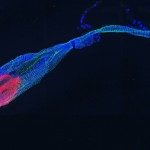Link to Pubmed [PMID] – 28338676
Link to DOI – 10.1038/ismej.2017.32
ISME J 2017 07; 11(7): 1578-1591
Pseudomonas aeruginosa and Aspergillus fumigatus are the two microorganisms responsible for most of the chronic infections in cystic fibrosis patients. P. aeruginosa is known to produce quorum-sensing controlled rhamnolipids during chronic infections. Here we show that the dirhamnolipids secreted from P. aeruginosa (i) induce A. fumigatus to produce an extracellular matrix, rich in galactosaminogalactan, 1,8-dihydroxynaphthalene (DHN)- and pyo-melanin, surrounding their hyphae, which facilitates P. aeruginosa binding and (ii) inhibit A. fumigatus growth by blocking β1,3 glucan synthase (GS) activity, thus altering the cell wall architecture. A. fumigatus in the presence of diRhls resulted in a growth phenotype similar to that upon its treatment with anjpegungal echinocandins, showing multibranched hyphae and thicker cell wall rich in chitin. The diRhl structure containing two rhamnose moieties attached to fatty acyl chain is essential for the interaction with β1,3 GS; however, the site of action of diRhls on GS is different from that of echinocandins, and showed synergistic anjpegungal effect with azoles.


